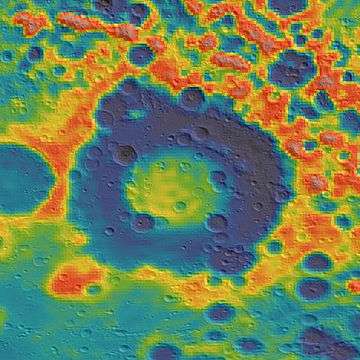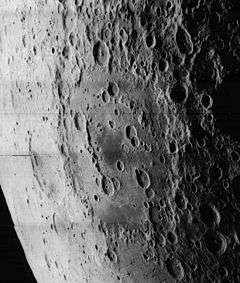Apollo (crater)
|
Oblique Lunar Orbiter 5 image | |
| Coordinates | 36°06′S 151°48′W / 36.1°S 151.8°WCoordinates: 36°06′S 151°48′W / 36.1°S 151.8°W |
|---|---|
| Diameter | 537 km[1] |
| Depth | Unknown |
| Colongitude | 161° at sunrise |
| Eponym | Project Apollo |
Apollo is an enormous impact crater located in the southern hemisphere on the far side of the Moon. This formation dwarfs the large crater Oppenheimer that is located next to the western rim. The crater Barringer lies across the northern wall. To the southeast is the crater Anders, and Kleymenov is just to the east of the rim.
Apollo is a double-ringed walled plain (or basin) whose inner ring is roughly half the diameter of the outer wall. Both the outer wall and the interior have been heavily worn and eroded by subsequent impacts, so that significant parts of the outer and inner walls now consist of irregular and incised sections of mountainous arcs.
The interior floor is covered in a multitude of craters of various sizes. Several of the more notable craters have received names. The IAU used the eponyms of people associated with the Apollo program when designating some of these formations.
Sections of Apollo's interior have been resurfaced with lava, leaving patches of the floor with a lower albedo than the surroundings. There is a large patch of this lunar mare in the middle part of the inner ring, which contains some ray system markings. A long stretch of the mare lies along the southern part of the crater. There is also a smaller section near the western rim.
-

Topographic map
-

Gravity map based on GRAIL
Interior craters
Several craters within the Apollo impact have been named to honor deceased NASA employees.
Dryden is attached to the west-northwestern exterior of the inner ring. Chaffee is a similar-sized crater that lies partly across the southwest section of the inner ring. In the southeast part of the outer crater is Borman. Inside the inner ring are the craters Resnik, McAuliffe and Onizuka, and the Jarvis–McNair crater pair. The crater Smith lies across the northern part of the inner ring.
In 2006 the IAU approved a proposal to name seven interior craters to honor the astronauts killed in the Space Shuttle Columbia disaster.[2][3]
| Crater | Coordinates | Diameter | Name source |
|---|---|---|---|
| Chawla | 42°48′S 147°30′W / 42.8°S 147.5°W | 15 km | Kalpana Chawla |
| D. Brown | 42°00′S 147°12′W / 42.0°S 147.2°W | 15 km | David McD. Brown |
| Husband | 40°48′S 147°54′W / 40.8°S 147.9°W | 29 km | Richard D. Husband |
| L. Clark | 43°42′S 147°42′W / 43.7°S 147.7°W | 16 km | Laurel B. S. Clark |
| McCool | 41°42′S 146°18′W / 41.7°S 146.3°W | 21 km | William C. McCool |
| M. Anderson | 41°36′S 149°00′W / 41.6°S 149.0°W | 17 km | Michael P. Anderson |
| Ramon | 41°36′S 148°06′W / 41.6°S 148.1°W | 17 km | Ilan Ramon |

Three of the crater names include the respective astronaut's first initials to distinguish them from the existing craters called Anderson, Brown and Clark.
References
- ↑ Don E. Wilhelms & Charles J. Byrne (23 January 2009). "Stratigraphy of Lunar Craters".
- ↑ Blue, Jennifer (2006-07-27). "Names for the Columbia astronauts provisionally approved". USGS Astrogeology. Archived from the original on 30 June 2006. Retrieved 2006-06-08.
- ↑ Blue, Jennifer (2006-08-30). "Provisional Names Approved". USGS. Retrieved 2007-05-07.
- Andersson, L. E.; Whitaker, E. A. (1982). NASA Catalogue of Lunar Nomenclature. NASA RP-1097.
- Blue, Jennifer (July 25, 2007). "Gazetteer of Planetary Nomenclature". USGS. Retrieved 2007-08-05.
- Bussey, B.; Spudis, P. (2004). The Clementine Atlas of the Moon. New York: Cambridge University Press. ISBN 978-0-521-81528-4.
- Cocks, Elijah E.; Cocks, Josiah C. (1995). Who's Who on the Moon: A Biographical Dictionary of Lunar Nomenclature. Tudor Publishers. ISBN 978-0-936389-27-1.
- McDowell, Jonathan (July 15, 2007). "Lunar Nomenclature". Jonathan's Space Report. Retrieved 2007-10-24.
- Menzel, D. H.; Minnaert, M.; Levin, B.; Dollfus, A.; Bell, B. (1971). "Report on Lunar Nomenclature by the Working Group of Commission 17 of the IAU". Space Science Reviews. 12 (2): 136–186. Bibcode:1971SSRv...12..136M. doi:10.1007/BF00171763.
- Moore, Patrick (2001). On the Moon. Sterling Publishing Co. ISBN 978-0-304-35469-6.
- Price, Fred W. (1988). The Moon Observer's Handbook. Cambridge University Press. ISBN 978-0-521-33500-3.
- Rükl, Antonín (1990). Atlas of the Moon. Kalmbach Books. ISBN 978-0-913135-17-4.
- Webb, Rev. T. W. (1962). Celestial Objects for Common Telescopes (6th revised ed.). Dover. ISBN 978-0-486-20917-3.
- Whitaker, Ewen A. (1999). Mapping and Naming the Moon. Cambridge University Press. ISBN 978-0-521-62248-6.
- Wlasuk, Peter T. (2000). Observing the Moon. Springer. ISBN 978-1-85233-193-1.
